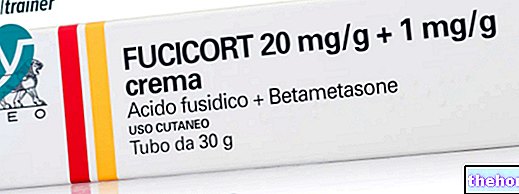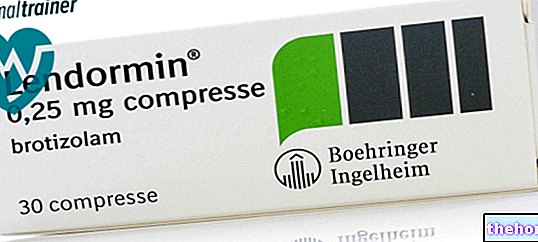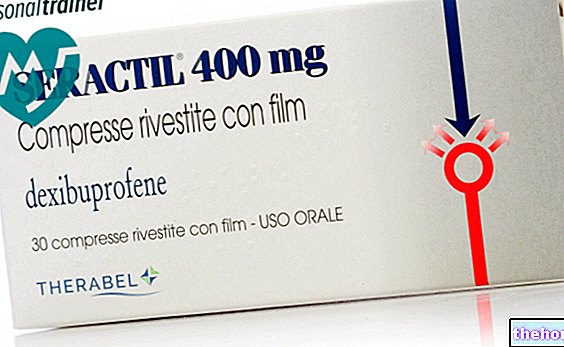Active ingredients: Memantine (Memantine hydrochloride)
Ebixa 10 mg film-coated tablets
Why is Ebixa used? What is it for?
Ebixa contains the active substance memantine hydrochloride. It belongs to a group of drugs known as anti-dementia drugs.
Memory loss in Alzheimer's disease results from a disturbance in the transmission of messages in the brain. The brain contains the so-called N-methyl-D-aspartate (NMDA) receptors involved in the transmission of nerve signals important for learning and memory.
Ebixa belongs to a group of drugs called NMDA receptor antagonists. Ebixa acts on these NMDA receptors by improving the transmission of nerve signals and memory.
Ebixa is used to treat patients with moderate to severe Alzheimer's disease.
Contraindications When Ebixa should not be used
Do not take Ebixa
- if you are allergic to memantine or any of the other ingredients of this medicine
Precautions for use What you need to know before taking Ebixa
Talk to your doctor or pharmacist before taking Ebixa
- if you have a history of seizures;
- if you have recently had a myocardial infarction (heart attack) or if you have congestive heart failure or uncontrolled high blood pressure.
In these situations, the treatment should be carefully monitored and the clinical benefits of Ebixa reassessed by your doctor at regular intervals.
In case of kidney malfunction (kidney problems), your doctor should carefully monitor your kidney function and, if necessary, adjust the memantine dosage accordingly.
Avoid concomitant use of medicinal products such as amantadine (for the treatment of Parkinson's disease), ketamine (a substance generally used as an anesthetic), dextromethorphan (generally used for cough treatment) and other NMDA-antagonists.
Children and adolescents
Ebixa is not recommended for children and adolescents under the age of 18.
Interactions Which drugs or foods can modify the effect of Ebixa
Tell your doctor or pharmacist if you are taking, have recently taken or might take any other medicines.
In particular, the effects of the following medicines may be altered by Ebixa and the dose may need to be adjusted:
- amantadine, ketamine, dextromethorphan
- dantrolene, baclofen
- cimetidine, ranitidine, procainamide, chiinidine, quinine, nicotine
- hydrochlorothiazide (or combinations with hydrochlorothiazide)
- anticholinergics (substances generally used to treat movement disorders or intestinal cramps)
- anticonvulsants (substances used to prevent and treat seizures)
- barbiturates (substances generally used to induce sleep)
- dopaminergic agonists (substances such as L-dopa, bromocriptine)
- neuroleptics (substances used in the treatment of mental disorders)
- oral anticoagulants.
In case of hospitalization, inform the medical staff that you are taking Ebixa.
Ebixa with food and drink
Talk to your doctor if you have recently changed or intend to substantially change your diet (for example from a normal diet to a strictly vegetarian diet) or if you suffer from renal tubular acidosis (RTA, an excess of acid-forming substances in the blood due to kidney dysfunction (insufficient kidney function)) or severe urinary tract infections (the structure that carries urine), as your doctor may need to adjust your drug dosage accordingly
Warnings It is important to know that:
Pregnancy and breastfeeding
If you are pregnant or breast-feeding, think you may be pregnant or are planning to have a baby, ask your doctor or pharmacist for advice before taking this medicine.
Pregnancy
The use of memantine in pregnancy is not recommended.
Feeding time
Women taking Ebixa should not breastfeed.
Driving and using machines
Your doctor will advise you on the advisability of driving or using machines with your condition.
In addition, Ebixa can change your readiness to react, making it inadvisable to drive or use machines.
Dose, Method and Time of Administration How to use Ebixa: Posology
Always take Ebixa exactly as your doctor has told you. Consult your doctor or pharmacist if in doubt.
The recommended dose of Ebixa for adult and elderly patients is 20 mg once a day. To reduce the risk of side effects, achieve this dose gradually following this daily schedule:
The usual starting dose is half a tablet once a day (1 x 5 mg) for the first week. The dosage is increased to one tablet once a day (1 x 10 mg) in the second week and to 1.5 tablets once a day in the third week. From the fourth week on, the usual dose is 2 tablets once a day (1 x 20 mg).
Dosage in patients with impaired renal function
If you have impaired kidney function, your doctor may decide on a dosage regimen suited to your condition. In this case, the monitoring of renal function at regular intervals should be requested by the doctor
Administration
Ebixa is given orally once a day. To benefit, you should take the drug regularly at the same time each day. Take the tablets with a little water. The tablets can be taken near or away from meals.
Duration of treatment
Keep taking Ebixa as long as it benefits you. Your doctor will evaluate your treatment at regular intervals.
Overdose What to do if you have taken too much Ebixa
If you take more Ebixa than you should
- In general, Ebixa overdose is not harmful. You may experience a greater number of symptoms described in the "Possible side effects" section.
- In the event of a significant overdose of Ebixa, contact your doctor as their intervention may be required.
If you forget to take Ebixa
- In case you forget to take a dose, take the next dose at the appointed time.
- Do not take a double dose to make up for a forgotten dose. If you have any further questions on the use of this medicine, ask your doctor or pharmacist.
Side Effects What are the side effects of Ebixa
Like all medicines, this medicine can cause side effects, although not everybody gets them.
In general, the side effects observed are mild to moderate.
Common (affects 1 to 10 in 100 people):
- Headache, sleepiness, constipation, elevated liver function tests, dizziness, balance disturbances, shortness of breath, hypertension and drug hypersensitivity.
Uncommon (affects 1 to 10 in 1000 people):
- Fatigue, fungal infections, confusion, hallucinations, vomiting, gait disturbances, heart failure and venous blood clotting (thrombosis / thromboembolism)
Very rare (affects less than 1 in 10,000 people):
- Convulsions
Not known (frequency cannot be estimated from the available data):
- Inflammation of the pancreas, inflammation of the liver (hepatitis), psychotic reactions.
Alzheimer's disease has been associated with depression, suicidal ideation and suicide. During post-marketing experience these events have been reported in patients treated with Ebixa.
Reporting of side effects
If you get any side effects, talk to your doctor or pharmacist. This includes any possible side effects not listed in this leaflet. You can also report side effects directly via the national reporting system listed in Appendix V. By reporting side effects you can help provide more information on the safety of this medicine.
Expiry and Retention
Keep this medicine out of the sight and reach of children.
Do not use this medicine after the expiry date which is stated on the carton and blister after EXP. The expiry date refers to the last day of the month.
This medicinal product does not require any special storage conditions.
Do not throw any medicines via wastewater or household waste. Ask your pharmacist how to throw away medicines you no longer use. This will help protect the environment.
What Ebixa contains
- The active substance is memantine hydrochloride. Each film-coated tablet contains 10 mg of memantine hydrochloride equivalent to 8.31 mg of memantine.
- The other ingredients are microcrystalline cellulose, croscarmellose sodium, colloidal anhydrous silicic acid and magnesium stearate, in the tablet core; and, in the tablet coating, are hydroxy-propyl-methyl-cellulose, macrogol 400 and titanium dioxide (E 171) and yellow iron oxide (E 172).
What Ebixa looks like and contents of the pack
Ebixa tablets are presented as pale yellow to yellow, oval shaped, film-coated tablets with a breakline and debossed "1 0" on one side and "MM" on the other side. divide into equal doses.
Ebixa tablets are available in blister packs of 14, 28, 30, 42, 49 x 1, 50, 56, 56 x 1, 70, 84, 98, 98 x 1, 100, 100 x 1, 112, 980 (10 x 98), or 1000 (20 x 50) tablets. The pack sizes 49 x 1, 56 x 1, 98 x 1 and 100 x 1 film-coated tablets are in unit dose blisters.
Not all pack sizes may be marketed.
Source Package Leaflet: AIFA (Italian Medicines Agency). Content published in January 2016. The information present may not be up-to-date.
To have access to the most up-to-date version, it is advisable to access the AIFA (Italian Medicines Agency) website. Disclaimer and useful information.
01.0 NAME OF THE MEDICINAL PRODUCT
EBIXA 10 MG TABLETS COATED WITH FILM
02.0 QUALITATIVE AND QUANTITATIVE COMPOSITION
Each film-coated tablet contains 10 mg of memantine hydrochloride equivalent to 8.31 mg of memantine.
For the full list of excipients, see section 6.1.
03.0 PHARMACEUTICAL FORM
Film-coated tablet.
Pale yellow to yellow, oval shaped film-coated tablet with breakline and debossed "1 0" on one side and "M M" on the other side.
The tablet can be divided into equal halves.
04.0 CLINICAL INFORMATION
04.1 Therapeutic indications
Treatment of adult patients with moderate to severe Alzheimer's disease.
04.2 Posology and method of administration
Treatment should be initiated and supervised by a physician experienced in the diagnosis and treatment of Alzheimer's dementia.
Dosage
Therapy should only be initiated if the person caring for the patient makes himself available to regularly monitor the administration of the drug to the patient. Diagnosis should be made following current guidelines. The tolerability and dosage of memantine hydrochloride should be reassessed regularly, preferably within three months of initiation of treatment. Therefore, the clinical benefit of memantine hydrochloride and the patient's tolerability of treatment should be regularly re-evaluated according to updated clinical guidelines.
Maintenance therapy can be continued as long as therapeutic benefit is present and the patient tolerates treatment with memantine. Discontinuation of treatment should be considered when there is no longer evidence of a therapeutic effect or if the patient cannot tolerate treatment.
Adults:
Dose titration
The maximum daily dose is 20 mg. To reduce the risk of side effects the maintenance dose is achieved by increasing by 5 mg per week for the first 3 weeks as follows:
First week (day 1-7):
The patient should take half a 10 mg film-coated tablet (5 mg) once a day for 7 days.
Second week (day 8-14) :
The patient should take one 10 mg film-coated tablet (10 mg) once daily for 7 days.
Third week (day 15-21) :
The patient should take one and a half 10 mg film-coated tablet (15 mg) once daily for 7 days.
From the fourth week onwards :
The patient should take two 10 mg film-coated tablets (20 mg) per day.
Dose from maintenance
The recommended maintenance dose is 20 mg per day.
Senior citizens:
Based on the clinical studies, the recommended dose for patients over 65 years of age is 20 mg per day (two 10 mg film-coated tablets once a day) as described above.
Impaired renal function: In patients with mildly impaired renal function (creatinine clearance 50-80 ml / min) no dose adjustment is required. In patients with moderately impaired renal function (creatinine clearance 30 - 49 ml / min) the daily dose should be 10 mg per day. If well tolerated after at least 7 days of treatment, the dose can be increased up to 20 mg per day, according to the standard titration schedule. In patients with severe renal impairment (creatinine clearance 5 - 29 ml / min) the daily dose should be 10 mg per day.
Impaired liver function: In patients with mildly or moderately impaired hepatic function (Child-Pugh A and Child-Pugh B), no dose adjustment is required. No data are available on the use of memantine in patients with severe hepatic impairment. Administration of Ebixa is not recommended in patients with severely impaired hepatic function.
Pediatric population:
No data are available.
Way from administration
Ebixa should be administered orally once a day and should be taken at the same time each day. The film-coated tablets can be taken near or away from meals.
04.3 Contraindications
Hypersensitivity to the active substance or to any of the excipients listed in section 6.1.
04.4 Special warnings and appropriate precautions for use
Caution is advised in patients with epilepsy, a previous history of seizures or patients with predisposing factors for epilepsy.
Avoid concomitant use of N-methyl-D-aspartate (NMDA) antagonists such as amantadine, ketamine, or dextromethorphan. These compounds act on the same receptor system as memantine, hence adverse reactions (mainly in the central nervous system - CNS ) may be more frequent or more pronounced (see also section 4.5).
Some factors that may increase urine pH (see section 5.2 "Elimination") require careful patient monitoring. These factors include drastic dietary changes, such as from a meat-based to a vegetarian diet, or excessive ingestion of stomach alkalizing buffers (antacids). Urine pH can also rise due to renal tubular acidosis (RTA) or severe urinary tract infections Proteus.
In most clinical trials, patients with recent myocardial infarction, uncompensated congestive heart failure (NYHA III-IV) or uncontrolled hypertension were excluded. Consequently, a limited amount of data is available and patients with these clinical conditions need to be monitored.
04.5 Interactions with other medicinal products and other forms of interaction
Due to the pharmacological effects and the mechanism of action of memantine the following interactions may occur:
• The mode of action suggests that the effects of L-dopa, dopamine agonists and anticholinergics may be enhanced during concomitant treatment with NMDA-antagonists, such as memantine. The effects of barbiturates and neuroleptics may be reduced. Concomitant administration of memantine with antispasmodic agents, dantrolene or baclofen, can modify their effects making it necessary to change the dosage.
• Avoid concomitant use of memantine and amantadine, due to the risk of pharmacotoxic psychosis. Both compounds are chemically associated with those of the NMDA antagonist type. The same is true for ketamine and dextromethorphan (see section 4.4). There is only one case. published on the possible risk deriving from the association between memantine and phenytoin.
• Other active substances such as cimetidine, ranitidine, procainamide, quinidine, quinine and nicotine, which use the same cationic renal transport system as amantadine, may also interact with memantine, leading to a potential risk of increased plasma levels.
• There may be a potential for decreased serum hydrochlorothiazide levels when memantine is co-administered with hydrochlorothiazide or with products containing combinations with hydrochlorothiazide.
• During post-marketing experience, isolated cases of increased International Normalized Ratio (INR) have been reported in patients on concomitant treatment with warfarin. Although a causal relationship has not been established, close monitoring of prothrombin time is recommended. or the INR in patients being treated with oral anticoagulants.
In single dose pharmacokinetic (PK) studies, in healthy young subjects, no relevant active substance interactions were observed between memantine and glyburide / metformin or donepezil.
In a clinical study in young healthy volunteers, no relevant effects of memantine on galantamine pharmacokinetics were observed.
Memantine did not inhibit CYP 1A2, 2A6, 2C9, 2D6, 2E1, 3A, flavin-containing monooxygenase, epoxy hydrolase, or sulfation in vitro.
04.6 Pregnancy and lactation
Pregnancy
There are no or only limited data on the use of memantine in pregnant women. Animal studies indicate that there is a possible reduction in intrauterine growth for drug exposure levels that are identical or slightly higher than human exposure levels (see section 5.3) The potential risk for humans is unknown Do not take memantine during pregnancy unless strictly necessary.
Feeding time
It is not known whether memantine is excreted in human milk, but given the lipophilicity of the substance, this is likely to occur. Women taking memantine should not breastfeed.
Fertility
No adverse reactions to memantine were observed on male and female injuries.
04.7 Effects on ability to drive and use machines
Generally, moderate to severe Alzheimer's disease can impair the ability to drive and use machines. As Ebixa has mild to moderate effects on the ability to drive or use machines, outpatients should be advised of the need for caution.
04.8 Undesirable effects
Summary of the safety profile
In clinical trials in mild to severe Alzheimer's disease, involving 1,784 patients treated with Ebixa and 1,595 patients treated with placebo, the overall incidence of adverse reactions in Ebixa treated did not differ from those treated with placebo; adverse reactions were generally mild to moderate in severity. Adverse reactions that occurred with a higher incidence in the Ebixa group than in the placebo group were dizziness (6.3% vs 5.6% respectively), headache (5 , 2% vs 3.9%), constipation (4.6% vs 2.6%) sleepiness (3.4% vs 2.2%) and hypertension (4.1% vs 2.8%).
Table of adverse reactions
The adverse reactions listed in the table below are derived from clinical studies with Ebixa and from post-marketing reports.
Adverse reactions have been classified according to system organ class and according to the frequency convention: very common (> 1/10), common (> 1/100 to 1 / 1,000 to 1 / 10,000 to
1 Hallucinations have mainly been observed in patients with severe Alzheimer's disease.
2 Isolated cases reported during post-marketing experience.
Alzheimer's disease has been associated with depression, suicidal ideation and suicide. During post-marketing experience these reactions have been reported in patients treated with Ebixa.
Reporting of suspected adverse reactions
Reporting of suspected adverse reactions occurring after authorization of the medicinal product is important as it allows continuous monitoring of the benefit / risk balance of the medicinal product. Healthcare professionals are asked to report any suspected adverse reactions via the national reporting system. in "Annex V.
04.9 Overdose
Only limited experience with overdose is available from clinical trials and post-marketing experience.
Symptoms:
Relatively large overdoses (200 mg and 105 mg per day for 3 days, respectively) have been associated with symptoms of fatigue, weakness and / or diarrhea or no symptoms. In cases of overdose with a dose of less than 140 mg or unknown, patients have experienced central nervous system symptoms (confusion, excessive tiredness, sleepiness, dizziness, agitation, aggression, hallucinations and gait disturbances) and / or of gastrointestinal origin (vomiting and diarrhea).
In the most extreme case of overdose, the patient survived oral intake of a total of 2000 mg memantine with central nervous system effects (coma for 10 days, followed by diplopia and agitation). The patient received symptomatic treatment. and plasmapheresis The patient recovered with no permanent sequelae.
In another case of high overdose, the patient also survived and recovered. The patient took 400 mg memantine orally. The patient experienced central nervous system symptoms such as restlessness, psychosis, visual hallucinations, proconvulsiveness, somnolence, stupor and unconsciousness.
Treatment:
In the event of an overdose, treatment should be symptomatic. There is no specific antidote for intoxication or overdose. Standard clinical procedures for the removal of the active substance, such as, for example, gastric lavage, activated charcoal medicines (disruption of enteric recirculation potential), should be used when appropriate. -hepatic), acidification of urine, forced diuresis.
In case of signs and symptoms of general central nervous system (CNS) overstimulation, careful symptomatic clinical treatment should be considered.
05.0 PHARMACOLOGICAL PROPERTIES
05.1 Pharmacodynamic properties
Pharmacotherapeutic category: Psychoanaleptics. Other anti-dementia drugs.
ATC code: N06DX01.
There is growing evidence that glutamatergic neurotransmission malfunction, particularly NMDA-mediated neurotransmission, contributes to both symptom manifestation and disease progression in neurodegenerative dementia.
Memantine is a voltage-dependent, moderate-affinity non-competitive NMDA receptor antagonist. It modulates the effects of pathologically elevated tonic levels of glutamate which can lead to neuronal dysfunction.
Clinical Studies:
A study with memantine monotherapy in the treatment of moderate to severe Alzheimer's disease (Mini Mental State Examination Total Score (MMSE)) at baseline ranging from 3 to 14 included 252 patients. The study demonstrated the efficacy of memantine treatment versus placebo at 6 months (observed case analysis Clinician's Interview Based Impression of Change (CIBIC-plus): p = 0.025; Alzheimer's Disease Cooperative Study - Activities of Daily Living (ADCSADLsev): p = 0.003; Severe Impairment Battery (SIB): p = 0.002.
A study with memantine monotherapy in the treatment of mild to moderate Alzheimer's disease (baseline MMSE total score 10 to 22) included 403 patients. Patients treated with memantine showed a statistically significant better effect than placebo on the primary endpoint: Alzheimer's Disease Assessment Scale (ADAS-cog) (p = 0.003) and CIBIC-plus (p = 0.004) at week 24 (last observation carried forward-LOCF). In another monotherapy study in the treatment of mild to moderate Alzheimer's disease (baseline MMSE total score 11 to 23) 470 patients were randomized. In the prospectively defined primary analysis, statistical significance was not reached at the primary efficacy endpoint at week 24.
A meta-analysis of patients with moderate to severe Alzheimer's disease (MMSE acetylcholinesterase total score) showed that there was a statistically significant effect in favor of memantine treatment for the cognitive, global and functional domains.When patients were identified for concomitant worsening in all three domains, the results showed the statistically significant effect of memantine in preventing worsening; twice as many placebo-treated patients showed worsening in all three domains. (21% vs. 11%, p
05.2 Pharmacokinetic properties
Absorption:
Memantine has an absolute bioavailability of approximately 100%. The Tmax is between 3 and 8 hours. There are no indications of the influence of food on memantine absorption.
Distribution:
Daily doses of 20 mg resulted in steady-state plasma concentrations of memantine ranging from 70 to 150 ng / ml (0.5 - 1 μmol) with considerable inter-individual variation. With the administration of daily doses ranging from 5 to 30 mg, a mean CSF CSF / serum ratio of 0.52 was calculated. The volume of distribution is around 10 l / kg.
About 45% of memantine is bound to plasma proteins.
Biotransformation:
In humans, about 80% of the circulating material related to memantine is present as the main compound. The major human metabolites are N-3,5-dimethyl-gludantane, the isomeric mixture of 4 and 6-hydroxy-memantine, and 1-nitrous-3,5-dimethyl-adamantane. None of these metabolites exhibit NMDA-antagonist activity. In vitro no cytochrome P 450 catalyzed metabolism was detected.
In a study with orally administered 14C-memantine, on average 84% of the dose was recovered within 20 days, with over 99% being renally excreted.
Elimination:
Memantine is eliminated in a monoexponential manner with a terminal t½ of 60 to 100 hours. In volunteers with normal renal function, the total clearance (Cltot) is 170 ml / min / 1.73 m2 and part of the total renal clearance occurs via tubular secretion.
Management at the renal level also involves tubular reabsorption, probably mediated by cation transport proteins. The renal elimination rate of memantine in the presence of alkaline urine can be reduced by a factor of 7 to 9 (see section 4.4).
Alkalization of the urine can result from drastic changes in the diet, for example from a meat-based diet to a vegetarian one, or from the massive ingestion of alkalizing gastric buffer solutions.
Linearity:
Studies on volunteers have shown linear pharmacokinetics in the dose range from 10 to 40 mg.
Pharmacokinetic / pharmacodynamic relationship:
At a memantine dose of 20 mg per day the CSF levels correspond to the ki value (ki = inhibition constant) of memantine, which is 0.5 μmol in the human frontal cortex.
05.3 Preclinical safety data
In short-term studies in rats, memantine, like other NMDA-antagonists, induced neuronal vacuolation and necrosis (Olney lesions) only after doses leading to very high peak serum concentrations. Ataxia and other preclinical signs preceded vacuolation and necrosis. Since the effects were not observed in long-term studies in various rodents and animals, the clinical relevance of these observations is unknown.
Ocular changes were inconsistently detected in repeated dose toxicity studies in rodents and dogs, but not in monkeys. Specific ophthalmoscopic examinations in clinical studies with memantine did not reveal any ocular changes.
In rodents, phospholipidosis was observed in pulmonary macrophages caused by accumulation of memantine in lysosomes. This effect is known from other active ingredients with cationic amphiphilic properties.
There is a possible correlation between this accumulation and the vacuolation observed in the lungs. This effect was only seen at high doses in rodents. The clinical relevance of these observations is unknown.
No genotoxicity was observed after memantine testing in standard analyzes. There is no evidence of carcinogenicity in life-long studies in mice and rats. Memantine was not teratogenic in rats and rabbits, even at maternally toxic doses, and no adverse effects of memantine on fertility were noted. In the rat, a reduction in fetal growth was observed at exposure levels identical or slightly above the human exposure.
06.0 PHARMACEUTICAL INFORMATION
06.1 Excipients
Compressed core:
Microcrystalline cellulose
Croscarmellose sodium
Anhydrous colloidal silicic acid
Magnesium stearate
Compressed coating:
Hydroxy-propyl-methyl-cellulose
Macrogol 400
Titanium dioxide
Yellow iron oxide
06.2 Incompatibility
Not relevant.
06.3 Period of validity
4 years.
06.4 Special precautions for storage
This medicinal product does not require any special storage conditions.
06.5 Nature of the immediate packaging and contents of the package
Blister: PVDC / PE / PVC / aluminum blister or PP / aluminum blister
Packs of 14, 28, 30, 42, 50, 56, 70, 84, 98, 100, 112 film-coated tablets.
Multipacks containing 980 (10 packs of 98) and 1000 (20 packs of 50) film-coated tablets.
Perforated unit dose blisters: PVDC / PE / PVC / aluminum blister or PP / aluminum blister.
Not all pack sizes may be marketed.
06.6 Instructions for use and handling
No special instructions.
07.0 MARKETING AUTHORIZATION HOLDER
H. Lundbeck A / S
Ottiliavej 9
2500 Valby
Denmark
08.0 MARKETING AUTHORIZATION NUMBER
EU / 1/02/219 / 001-003
035681016
035681030
EU / 1/02/219 / 007-012
035681079
035681081
035681093
EU / 1/02/219 / 014-021
09.0 DATE OF FIRST AUTHORIZATION OR RENEWAL OF THE AUTHORIZATION
Date of first authorization: May 15, 2002
Date of last renewal: May 15, 2007
10.0 DATE OF REVISION OF THE TEXT
D.CCE September 2015























-nelle-carni-di-maiale.jpg)




